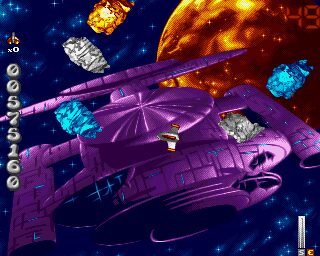Smash T.V. is an arcade game created by Eugene Jarvis and Mark Turmell for Williams Electronics and released in 1990. It was later ported to several platforms, including Genesis, Amiga, Atari ST, NES, Master System, SNES, and many others.
The game presents a dystopian vision where contestants fight for their lives on live television, battling through rooms filled with murderous robots, mutants, and psychopaths for the chance to win "big money, big prizes!" Players are dropped into this televised bloodbath where survival means mowing down endless waves of enemies while collecting cash, keys, and power-ups scattered across each arena-like room. The gameplay builds directly on Jarvis's earlier masterpiece Robotron: 2084, using the same twin-stick control scheme where one joystick moves your character while the other fires in eight directions. Players progress through increasingly chaotic rooms, each packed with different enemy types - from basic grunts to heavily armed soldiers, spiders, and screen-filling boss monsters. The genius lies in the risk-reward mechanics: while survival is paramount, greed drives you to dash into danger for cash bonuses and weapon upgrades like the devastating bazooka or the rapid-fire toaster gun.
Eugene Jarvis and Mark Turmell's Smash T.V. stands as one of the most perfectly realized twin-stick shooters ever created, sharing DNA not only with Robotron: 2084 but also drawing inspiration from the chaotic multi-directional combat seen in games like Alien Syndrome. The question isn't whether the arcade original was brilliant - it's how well these home conversions captured that lightning in a bottle. Jarvis would later revisit similar themes with Total Carnage, which served as a spiritual sequel with even more over-the-top violence and satirical edge.
Ocean Software's Amiga conversion immediately impresses with its commitment to preserving the visual spectacle. The screen-filling carnage translates remarkably well, with smooth scrolling and fluid sprite movement that showcases the Amiga's custom chipset capabilities. The color palette closely matches the arcade's garish neon aesthetic, and the explosion effects retain much of their satisfying punch. Regarding controls, the Amiga version offers several options. Single players can use two joysticks to achieve the authentic twin-stick experience - a setup that faithfully recreates the original arcade control scheme. However, for two-player cooperative gameplay, four joysticks total are needed (two per player), requiring a 4-port adapter that wasn't very common among Amiga owners. For those without this ideal configuration, Ocean implemented an alternative scheme using joystick and keyboard, where you move with the joystick and fire in eight directions using keyboard keys - a playable compromise that never quite achieves the intuitive flow of the full twin-stick setup.
The audio deserves particular praise - the Amiga's sound capabilities shine through with digitized speech samples that maintain the cheesy game show atmosphere. "Big money! Big prizes! I love it!" comes through with satisfying clarity, and the weapon sound effects pack appropriate punch, creating an atmosphere that rivals other audio-heavy action games of the era like Defender II.
Acclaim's Genesis conversion takes a different approach, prioritizing gameplay flow over visual fidelity. While the graphics are notably scaled back - smaller sprites, reduced on-screen enemies, simplified backgrounds - the game achieves something crucial: it feels right to play. The Genesis controller's six-button layout allows for more intuitive firing controls, with theface buttons handling directional shooting. It's not perfect, but it's considerably more playable than the Amiga's hybrid keyboard approach when dual joysticks aren't available. The reduced visual chaos actually helps in some ways, making it easier to track threats and power-ups in the mayhem, something that becomes crucial in the later, more intense rooms that rival the overwhelming enemy density of games like Gauntlet.
Audio-wise, the Genesis version suffers from the console's sound limitations. The speech samples are heavily compressed and lose much of their impact, while the music, though energetic, lacks the punch of the Amiga version.
Both versions preserve the core Smash T.V. experience: the relentless room-to-room progression, the satisfying weapon upgrades (toasters, bazookas, scatter shots), and that addictive "just one more room" compulsion. The game's genius lies in its escalating chaos - what starts manageable quickly becomes an overwhelming bullet-hell experience that demands pattern recognition and spatial awareness, much like the frantic gameplay found in Berzerk or the later Geometry Wars series would perfect years later.
The influence of Jarvis's earlier Robotron: 2084 is clear, but Smash T.V. adds layers of complexity with its varied enemy types, boss battles, and the brilliant risk-reward mechanic of grabbing cash and prizes while dodging death. The game show theme isn't just window dressing - it perfectly frames the excessive violence with dark humor that would later be expanded upon in Total Carnage. This satirical approach to violence-as-entertainment distinguished it from more straightforward shooters like Commando or Ikari Warriors, giving players permission to enjoy the mayhem through its tongue-in-cheek presentation.
The Amiga version, when played with the ideal twin-stick configuration, offers the most authentic and faithful arcade experience, both visually and aurally. However, this optimal setup required additional hardware that wasn't commonly available, limiting accessibility to the complete experience. The Genesis version, while less spectacular to look at, guaranteed a more consistent experience for all players with decent controls out-of-the-box. For pure accessibility and immediate playability, it remains the more practical home version.
The superiority of one version over the other essentially depends on available hardware: with two joysticks, the Amiga wins easily; without them, the Genesis offers the better compromise. Both versions stand as solid representations of one of the arcade's finest twin-stick shooters, a game that influenced countless successors and remains a benchmark for chaotic, skill-based action gaming.













